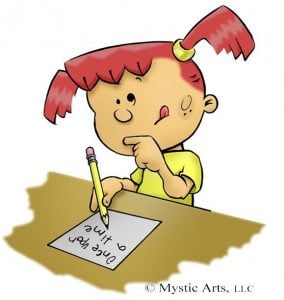by C. Elkins, OK Math and Reading Lady
So many teachers have asked for assistance with writing – so here is Part 1. Stay tuned for more parts devoted to helping students become better writers.
Sometimes it’s hard to know where to start with writing. Do you have these thoughts?
- What type of paper is best? Lined, unlined, wide rule, college rule, dotted lines?
- How much should I help them with spelling? Does it need to be spelled correctly?
- Should I use prompts or free choice journaling?
- How do I get students to space correctly?
- How do I get students to stay on a topic?
- How do I get students to use the conventions we have worked on (capitalization, punctuation, etc.)
- What do I do about handwriting issues?
- How can I connect it with reading, math, or other subjects?
At the root of all of these issues above, I believe the following are musts for any grade level:
- Students must be exposed to quality literature which highlights a variety of writing styles. This is accomplished through the books you use in guided reading, whole group reading, and especially your daily read aloud time. Through this rich exposure to literature students become familiar with various authors and their styles of writing, as well as how authors use their “voice” to relay their message. Voice is the ability to project the way you talk into print. (More info in later posts about books that really show different types of “voice.”)
- Students can’t be expected to write if they don’t see the teacher model writing. Through modeling, teachers can use dozens of “think alouds” to share the decisions they are making. In this way, the strategies a writer (the teacher) uses are being exposed. Then the students are more likely to emulate these strategies.
- Writing needs to be scaffolded in the same way as other lessons: I do – we do – you do. Students observe and watch the teacher as he/she models various writing strategies. With shared writing, the teacher and students work together to “share the pen.” Then we gradually release students through guided writing sessions before expecting independent writing. This is a year-long process.
- Sometimes your writing strategy lessons might best be accomplished through your small group literacy time. Students are probably grouped based on their reading needs, so they likely have similar writing needs. From my experience, it’s a lot easier to monitor 4-6 students’ writing than a whole class. In this case a goal could be to write once a week as part of your weekly routine. (Example: Monday and Tuesday are spent on the guided reading text for the week, Wednesday on word work, and Thursday for writing.)
Some of you may have heard of Gail Tompkins, noted author and expert in the field of elementary writing. This illustration of the writing stages children go through has always stuck with me. It is modified from one she actually presented. 
- It often appears as scribbles at first (because that is what a child’s sense of writing is).
- Pictures are also used as a way to communicate a message.
- Then children learn that people use letters of the alphabet to write, but don’t yet know that letters are associated with certain sounds. So the result is often random letters.
- As they start learning letter sounds, they approximate the spelling of the word by writing what they hear (which is usually the strong consonant sounds at the beginning and/or end of words).
- Children’s move toward conventional spelling means that for words they don’t know, they are allowed to use temporary spelling. The teacher observes how students are able to recall the consonant and vowel sounds using a common spelling pattern. So words such as like or name are spelled without the silent e (because it’s silent!!).
- As children acquire sight words and are exposed to more words through reading and spelling practice, they demonstrate more and more conventionally spelled words.
The teacher uses this information from the continuum to plan instructional strategies. Often students don’t know what to do. Do they know the difference between letters, words, and sentences? This is often why there are spacing problems – because they don’t know the difference. Do they know to go left to right? Where do you go when you get to the end of the line? Are we modeling this with students, or do we assume? What does the child do when they don’t know how to write a word? Have we introduced and practiced plenty of strategies? Pictured here is a chart I made highlighting some of the beginning writing strategies often needed in KG-2nd grade. A pdf of this chart is available by clicking HERE. 
One of the reasons I made it, is because students seem to know they should try to “sound out” a word they want to spell – but there are several strategies to try to get them to slow down this process so they are hearing each sound one syllable at a time, are thinking about known words with the same sound, are taking advantage of a print rich classroom, and are also looking at the word to see if it “looks right.”
Lots more to come! Stay tuned.
My struggle right now is getting them to write more than a sentence or two. Thank you for starting this writing series, I have much to learn. Writing is my own area of weakness so I need all the help I can get to teach it. 😉